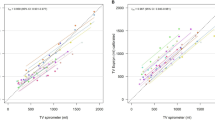Summary
To validate the accuracy and consistency of respiratory inductive plethysmography (RIP) in measuring tidal volume after an overnight sleep, tidal volumes of 18 patients with suspected sleepdisordered breathing and 8 normal volunteers were measured simultaneously with RIP (VTRIP) and with an ultrasonic airflow meter (VTUFM) before and after an unstrained overnight sleep on supine and lateral decubitus. The bias of the VTRIP was expressed as (VTRIP-VTUFM)/ VTUFM 100 %, limits of agreement between VTRIP and VTUFM was measured by averaged bias ±2s. Results showed that in normal subjects, the bias of RIP before and after overnight sleep was precise and consistent in both supine (0. 7 % and -1. 6 %) and lateral decubitus (3. 7 % and -0. 56 %). In these patients, the bias of RIP before and after sleep in supine also remained small (1. 9% and 1.7%), but it became larger in lateral decubitus (24. 5 % and 20. 4 %) and 11. 5 % exceeded the limits of agreement observed in the evening. The patients’ body mass indices (BMI) were higher than those of normal subjects (median 34. 2 vs. 27. 8 kg/m2). Pooled data showed that the bias of VTRIP in the morning on lateral decubitus but not on supine was correlated to BMI (Spearman R = 0. 32, n=52,P=0.02). Thus, we were led to conclude that the accuracy of VTRIP overnight was precise and consistent in normal subjects, but the deviation of VTRIP measured on lateral decubitus in patients especially in those with excessive obesity was greater, thus, the method should not be used for quantitative determination.
Similar content being viewed by others
References
Kaplan V, Zhang J N, Russi E Wet al. Detection of inspiratory flow limitation during sleep by computer assisted respiratory inductive plethysmography. Eur Respir J, 2000, 15: 570
Bloch K E, Li Y, Sackner M Aet al. Breathing pattern during sleep disruptive snoring. Eur Respir J, 1997, 10: 576
Cohn M A, Rao A S V, Broudy Met al. The respiratory inductive plethysmograph: A new non-invasive monitor of respiration. Bull Eur Physiopathol Respir, 1982, 18: 643
Konno K, Mead J. Measurement of the separate volume changes of rib cage and abdomen during breathing. J Appl Physiol, 1967, 22: 407
Sackner M A, Watson H, Belsito A Set al. Calibration of respiratory inductive plethysmograph during natural breathing. J Appl Physiol, 1989, 66: 410
Buess C, Pietsch P, Guggenbuehl Wet al. A pulsed diagonal-beam ultrasonic airflow meter. J Appl Physiol, 1986, 61: 1195
Bland J M, Altman D G. Statistical methods for assessing agreement between two methods of clinical measurement. Lancet, 1986, (8): 307
Paek D, McCool D F. Breathing pattern during varied activities. J Appl Physiol, 1992, 73: 887
Author information
Authors and Affiliations
Rights and permissions
About this article
Cite this article
Jinnong, Z., Ruch, E.W. & Bloch, K.E. Accuracy and consistency of respiratory inductive plethysmography for overnight tidal volume measurement. Current Medical Science 21, 35–37 (2001). https://doi.org/10.1007/BF02888032
Received:
Published:
Issue Date:
DOI: https://doi.org/10.1007/BF02888032




